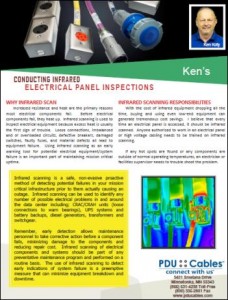KEN'S KORNER - Infrared Electrical Panel Inspection
Conducting Infrared Electrical Panel Inspections
Why Infrared Scanning
Increased resistance and heat are the primary reasons most electrical components fail. Before electrical components fail, they heat up. Infrared scanning is used to inspect electrical equipment because excess heat is usually the first sign of trouble. Loose connections, imbalanced and or overloaded circuits, defective breakers, damaged switches, faulty fuses, and material defects all lead to equipment failure. Using infrared scanning as an early warning tool for potential electrical equipment/system failure is an important part of maintaining mission critical uptime.
Infrared Scanning Responsibilities
With the cost of infrared equipment dropping all the time, buying and using even low end equipment can generate tremendous cost savings.
I believe that every time an electrical panel is accessed, it should be infrared scanned. Anyone authorized to work in an electrical panel or high voltage cabling needs to be trained on infrared scanning.
If any hot spots are found or any components are outside of normal operating temperatures, an electrician or facilities supervisor needs to trouble shoot the problem.
Infrared Scanning the Electrical Panel
Electrical switchgear and panels are the lifeblood of a data center. Without it, equipment failure is immediate. Infrared scanning can identify problems prior to failure, allowing you to take proactive steps to prevent costly and sometimes dangerous electrical outages.
If you are a dual powered or utilizing redundant power sources, anytime you switch over power from primary to a backup power source infrared scan the switchgear and backup PDU/RPP electrical panel boards and branch circuits for excessive heat. Testing while under load will tell you if there has been any degradation in the system components that could lead to future equipment failure and a possible outage.
Open and scan the electrical panel and look for hot spots. Loose or week connections between breakers and the main panel bus and other deficiencies including overloaded circuits, load imbalances, harmonic problems and defective electrical components can all contribute to a thermal scan heat signature.
When a hot spot is identified, amp probe the circuit to measure the draw. Calculate loads to determine if the problem is related to excessive load to one or a number of circuits. If the draw is less than 80% of the circuit capacity, focus your attention on the circuit breaker or wiring connections to the electrical panel. Check for loose or week connections between a breaker and the main panel bus. Systematically work through the components (testing and replacing if necessary), and electrical connections (checking for loose connections and tightening if possible) until the problem is isolated and resolved. If the draw exceeds 80% of the circuit capacity, back track to the draw source. Has additional equipment been added to the circuit?
Anytime someone needs to access an electrical panel, power distribution unit or remote power panel, they should infrared scan the branch circuits and breakers for excessive heat. Even if you find yourself in an electrical panel every week, it only takes a few seconds to scan and determine if a problem exists. Though it’s unlikely that screws have loosened in the past week, they do loosen up over time.
More likely, in a busy data center it is common for IT to have added new servers into an existing rack without telling facilities management, increasing the load on a 20 amp circuit from 16 to 18 or 19 amps, pushing that circuit over the NEC guidelines of 80% of amp capacity, if it is a under load, meaning it is energized continuously for three or more hours.
I used to tell our IT people that just because there are outlets in a power strip doesn’t mean there is electrical capacity on the circuit to support the added equipment. Remember to ask before you plug in. Regardless of my best efforts to be informed of all new equipment installation into the data center, I’ve personally learned about newly installed equipment when amp probing a circuit to resolve hot spots after an infrared scan of a circuit panel.
I also recommend that anytime someone installed or replaced a branch circuit breaker, you should infrared scan it for problems. You don’t always have to wait for the circuit to trip or fail to identify a potential problem. The infrared scan can tell you right away if the breaker or wires are properly secured or if the installation dislodged adjacent wires.
Summary
Infrared scanning is a safe, non-evasive proactive method of detecting potential failures in your mission critical infrastructure prior to them actually causing an outage. Infrared scanning can be used to identify any number of possible electrical problems in and around the data center including; CRAC/CRAH units (loose connections to warn bearings), UPS systems and battery backups, diesel generators, transformers and switchgear.
Remember, early detection allows maintenance personnel to take corrective action before a component fails, minimizing damage to the components and reducing repair cost. Infrared scanning of electrical components and systems should be part of any preventative maintenance program and performed on a routine basis. The use of infrared scanning to detect early indications of system failure is a preemptive measure that can minimize equipment breakdown and downtime.
Ken Koty

